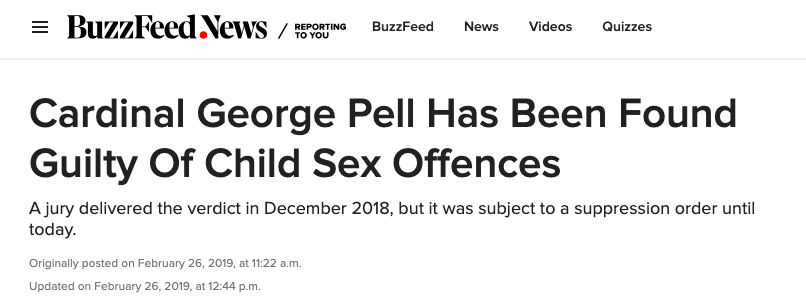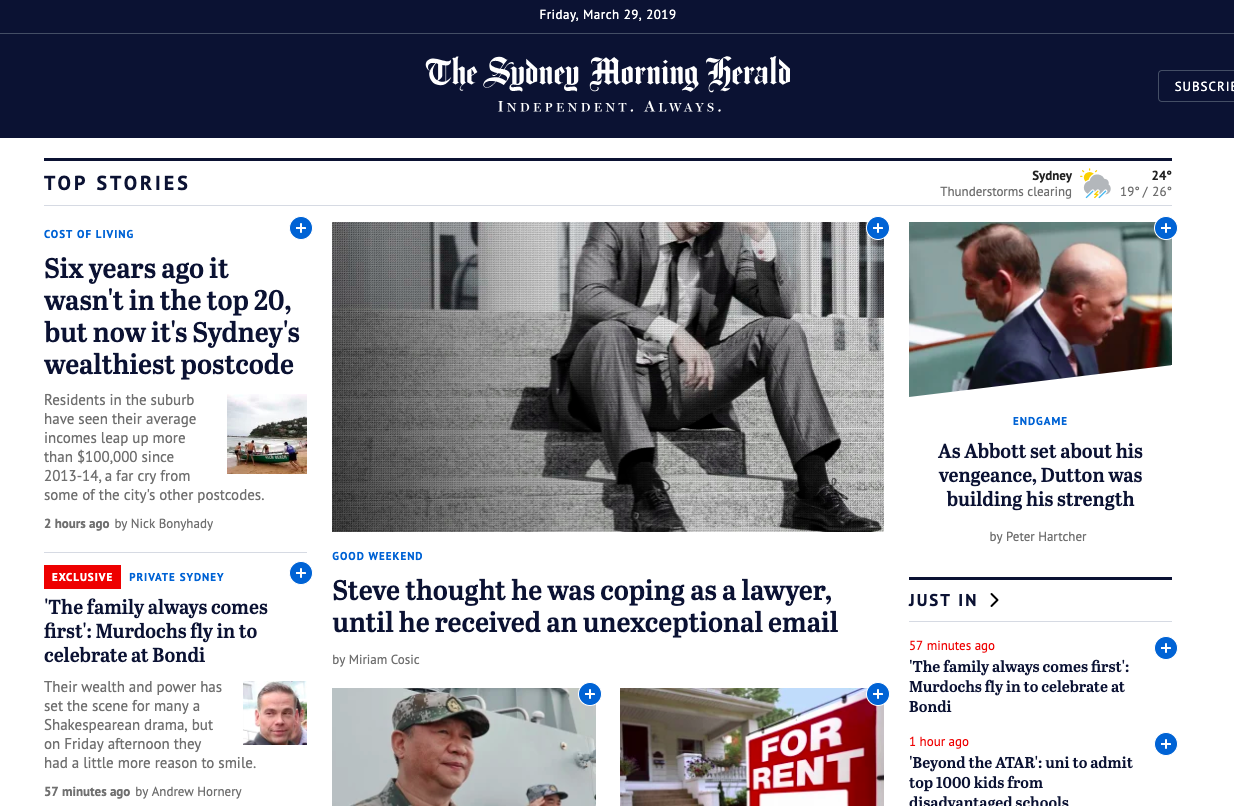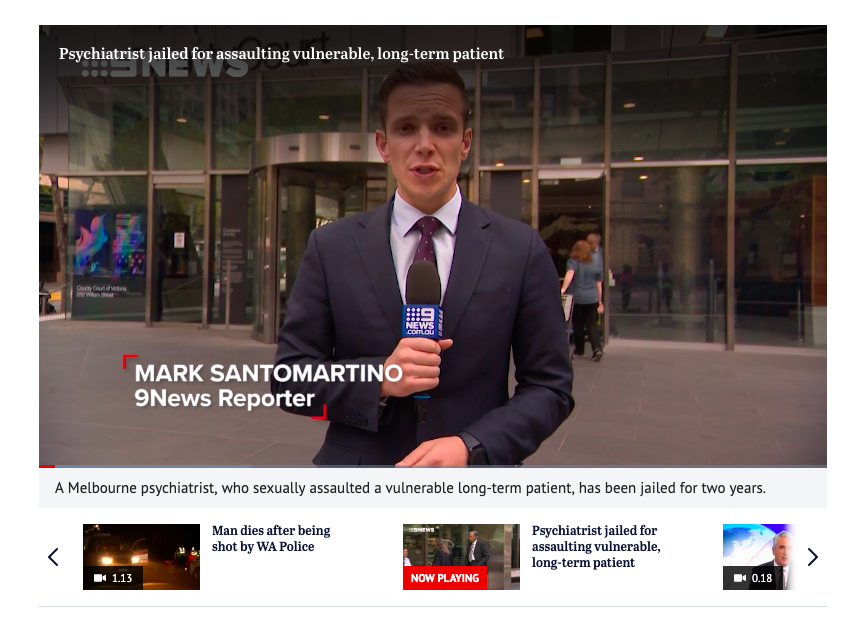
I’m not sure if this is appropriate language, but I’m just gonna say it because this is a blog: When digital born news platforms started to thrive in the news commercial market since 2003 (Bradshaw, 2018, p. 11), it did light a fire under traditional publishers’ ass.
Either they pushed their printed journalists to become multiskilled professionals, or they hire some millennials to help them with multi-platform delivery. One way or another, traditional publishers will not let these “newbies” take their readership, and more importantly, market share away that easily. And in my humble opinion, they did not.
You would think digital born news platform like BuzzFeed News (Bradshaw, 2018, p. 11) will somehow be advanced in online journalism, that is not the case all the time.
In the following parts, I will analyse two news articles reporting on the case of Cardinal George Pell, from Sydney Morning Herald and BuzzFeed News representing legacy brand national news publication and digital born service.
Sydney Morning Herald: “Cardinal George Pell sent to jail after being convicted of child abuse”.

BuzzFeed News: “Cardinal George Pell Has Been Found Guilty Of Child Sex Offences”.

Platforms Overview
The Sydney Morning Herald
The Sydney Morning Herald (SMH) was found in 1831 and it is the oldest continuously published newspaper in Australia and a national online news brand (Lagan, 2012). SMH is currently owned by Nine Publishing in Sydney and the print version of the newspaper is published six days a week.
In 1995, the company launched the newspaper’s web edition smh.com.au. As media technology develops, the website has since grown to include interactive and multimedia features beyond the content in the print edition (Souter, 2013). However, it wasn’t until 2012 when SMH started to fully invest in online platforms.
The overall “digital first” transformation included shifting broadsheet newspapers to tabloid size, increasing the amount of online content over printed delivery and erecting paywalls around the website (Souter, 2013).

According to the company’s media kit (ABC Centre, 2018), SMH reaches 5 million people across desktop, mobile, tablet and print each month. The audience review suggests that SMH owns a more mature readership because only 21% of the readers are aged from 14-29. Moreover, the amount of male readers is noticeably larger than female readers.

In terms of the website’s traffic, it ranks 35 in Australia (SimilarWeb, 2019) with 69.2% local readers (Alexa, 2019). An average visitor would look at 2.62 pages per visit and spend 4 minutes 3 seconds on the site. They have a bounce rate of 63.75% (SimilarWeb, 2019).

BuzzFeed News
BuzzFeed News started as a division of BuzzFeed in December 2011 with the appointment of Ben Smith as editor-in-chief (Mullin, 2017). It was developed to be a less entertainment-focused version of BuzzFeed, or as some critics might call it BuzzFeed but with “real journalism” (Fisher, 2014).
Unlike BuzzFeed articles, BuzzFeed News predominantly uses inverted pyramid news format, and journalists’ opinions are absent from the majority of articles. Yet, BuzzFeed News still shares the same readership as BuzzFeed which is mainly millennial.

By 2016, BuzzFeed News had 20 investigative journalists, achieving notable coverage includes a 2012 partnership with the BBC on match-fixing in professional tennis, and inequities in the U.S. H-2 guest worker program which won a National Magazine Award (Mullin, 2017).
Due to overall success, BuzzFeed News was moved from a section of the BuzzFeed site to its own domain, BuzzFeedNews.com on July 18, 2018, with its own Trending News Bar and programmatic advertisements (Wang, 2018).
According to SimilarWeb (2019), it ranks 928 in America with 66.89% local readers and 1.99% Australian readers. An average visitor would look at 1.44 pages per visit and spend 1 minutes 44 seconds on the site.
What’s worth noticing is that, the total visit of BuzzFeedNews.com in the last 6 months is 23.34 million, which is interestingly close to SMH’s 26.62 million. However, BuzzFeed News has a visitor bounce rate of 75.34%, which is quite high suggesting SMH has a more engaging readership.

Who Did It Better?
The two stories I chose were published on the 26th and 27th of February, when Cardinal George Pell was sent to jail after being convicted of child abuse. Since both articles used almost the same keywords in the headings, an analysis of their search engine optimisations is not necessary.
In terms of the writing style, SMH provided the readers with a nice flow of narrative of the issue while BuzzFeed News informed the readers with all the key message straight away, which were both reasonable considering each readers’ demographics.
For the more mature audience, SMH mainly focused on the quotes from the judge, the barrister and the prosecutor. And to follow its usual reporting habit in similar situation (Tandoc, 2017), BuzzFeed News frequently quoted the victim.
It’s not realistic to compare the their journalism writing because both articles fitted in their own platforms nicely.
Therefore, in the next part, I will apply Bradshaw’s BASIC principles (2018) for web writing to determine which news platform did a better job in online delivery.
B – Brevity
It could be said that these two articles achieved brevity in their own way.
First of all, they both contained around 500 words and all paragraphs had no more than two sentences. Secondly, both BuzzFeed News and SMH kept the stories brief, but BuzzFeed News included only the basic facts of the verdict and allowed readers to get a full grasp of the most news-worthy content in the first few paragraphs. It made sense for a platform with such young readership.
Although SMH reporters clearly made more effort in improving the narrative with foreshadowing, the content was still relevant and possibly more appreciated by SMH’s mature readership. As a result, it appeared to be well-written instead of lengthy.

A – Adaptability & I – Interactivity
This is the part where SMH really distinguished itself from BuzzFeed News on this very topic.
SMH fully took advantage of web writing to tell a story, by embedding relevant stories, an audio of a court reporter narrating what happened in court and a 9News video reporting on the issue. SMH reporters did not convert these contents into textual descriptions which might increase the word count, instead, they inserted them within the article for those who are interested in more in-depth information.

The well use of multi-media made SMH’s article more adaptable and interactive, while BuzzFeed News had only one featured image. This was strange for BuzzFeed’s brand because we usually expect their reporters to utilise the digital form to write a story, such as embedding many images and relevant social media comments.
It’s not reasonable to require BuzzFeed writers to use multi-media in all online coverages, but let’s just say that this piece was underwhelming in comparison.

S – Scannability
Neither of these two articles had subheadings or summaries for readers who are just scanning through the screen and looking for key information.
SMH did successfully break up the text with three kinds of multi-media content, but it would be better if these materials were placed according to the narrative. For example, the audio of the court reporter could be placed before the part where the SMH reports describe what had happened in court. In that way, the audio record can work as a subheading.

In terms of related stories, SMH placed them along with the article, in the form of feature image and heading, which is very eye-catching. Meanwhile, BuzzFeed News embedded a link to a relevant story within the text and added another link at the bottom of the page.
Since SMH’s links were more visually pleasing, they drew the readers eyes down the page and engage them for longer (Bradshaw, 2018, p. 81), therefore they were more effective in terms of web writing.

C – Community/Conversation
Once again, SMH scored a big one in this principle.
As a national leading news platform, SMH fulfilled its responsibility by promoting National Sexual Assault, Domestic and Family Violence Counselling Service in the last paragraph of the article.
Not only did it show support associated communities, it also sparked the conversation to a serious social issue. This section was closely followed by a comment section where readers can see the comments without clicking anything.

BuzzFeed News on the other hand required readers to click “Read Comment” to see the comment section.

Also, the comment section is only available in BuzzFeed’s smartphone app, but not on the website.

Conclusion
Based on the analysis above, it is obvious that SMH did a better job in reporting on Cardinal George Pell’s conviction in terms of online journalism. BuzzFeed News’ article was not nicely adaptable to its platform, also lacking of interactivity and scannability. It certainly did not serve a community like SMH did.
Word count: 1547
Reference:
ABC Centre. (2018). The Sydney Morning Herald Media Kit. Retrieved from https://www.adcentre.com.au/wp-content/uploads/2017/08/18-The-Sydney-Morning-Herald-Media-Kit-2018-Final.pdf
Bradshaw, P. (2018). Histories, futures and the changing business and technologies of online journalism. Online Journalism Handbook: Skills to survive and thrive in the digital age, 5–50, Routledge.
Bradshaw, P. (2018). Writing for the Web. The Online Journalism Handbook: Skills to survive and thrive in the digital age, 72–98, Routledge.
Fisher, M. (2014). Who cares if it’s true. Columbia Journalism Review. Retrieved from https://archives.cjr.org/cover_story/who_cares_if_its_true.php
Mullin, B. (2017). BuzzFeed News gets its first Pulitzer citation. Retrieved from https://www.poynter.org/reporting-editing/2017/buzzfeed-news-gets-its-first-pulitzer-citation/
Lagan, B. (2012). “Breaking: News and hearts at the Herald”. Global Mail. Retrieved from https://web.archive.org/web/20120623194413/http://www.theglobalmail.org/feature/breaking-news-and-hearts-at-the-herald/277/
SimilarWeb. (2019). “BuzzFeed News. Feburary 2019 Overview”. Retrieved from https://www.similarweb.com/website/buzzfeednews.com#overview
SimilarWeb. (2019). “smh.com.au. Feburary 2019 Overview”. Retrieved from https://www.similarweb.com/website/ smh.com.au
Souter, G. (2013, March 1). “History makes way for compact future”. The Sydney Morning Herald. Retrieved from https://www.smh.com.au/national/history-makes-way-for-compact-future-20130228-2f8xj.html
Tandoc, E. (2017). “Five ways BuzzFeed is preserving (or transforming) the journalistic field”. Journalism, 19 (2), 200–216. doi:10.1177/1464884917691785.
Wang, S. (2018). “The investigations and reporting of BuzzFeed News — *not* BuzzFeed — are now at their own BuzzFeedNews.com”. NiemanLab. Retrieved from http://www.niemanlab.org/2018/07/the-investigations-and-reporting-of-buzzfeed-news-not-buzzfeed-are-now-at-their-own-buzzfeednews-com/





Be the first to comment